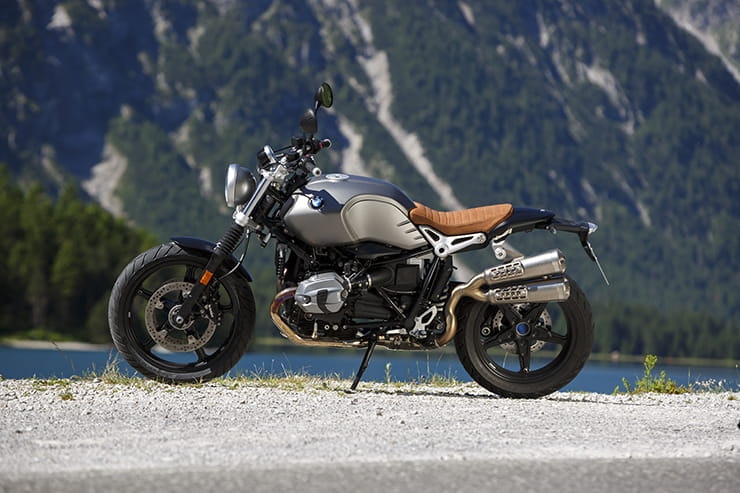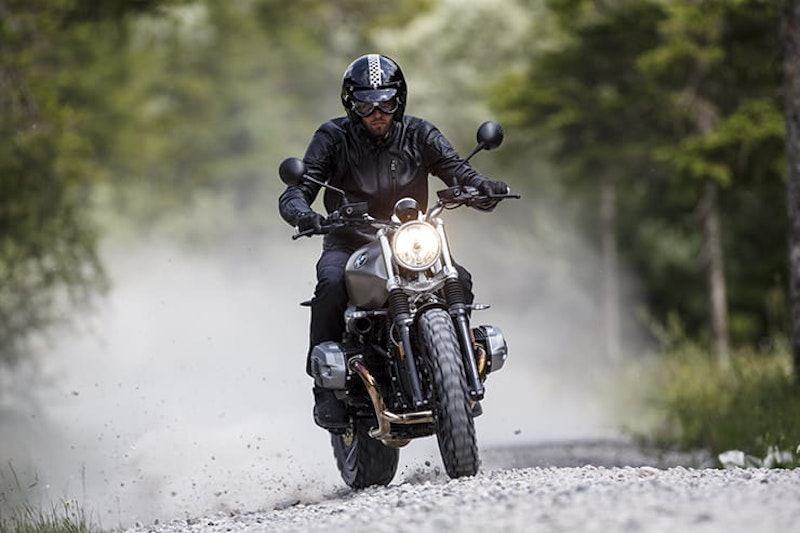Another day, another Scrambler, although this time BMW’s offering into this fashion-pleasing market actually has some proper kahunas to back its macho styling up. While the likes of the Ducati Scrambler and Triumph Street Twin Scrambler (created using a £1745 inspiration kit) are generally aimed at those less hirsute when it comes to their motorcycling experience, the BMW R nineT Scrambler is for men with full grown bushy beards who wear lumberjack shirts with a small smattering of chest wig protruding out of the top…
As the Scrambler’s name suggests, its look is based around an off-road image. Essentially, BMW have looked at the current trends that are doing the rounds in shows such as Bike Shed and Wheels and Waves and by using the R nineT platform as a base (the café racer is now called the Roadster), created a new model. And there is absolutely nothing wrong in doing this as the R nineT is a brilliant basis, and extremely popular model that has to date sold over 25,000 units worldwide, with which to develop upon. And one that now has a genuine longterm future.
A huge part of the Roadster’s success since its launch in 2014 is the fact it has an air-cooled boxer engine beating at its heart rather than the latest partially water-cooled boxer unit. The problem with this is that 2017 sees new Euro4 emissions laws entering force and that has all but killed the large capacity air-cooled engine off. Thankfully for fans of cubes and fins on their engine’s barrels, some clever work by BMW on the exhaust system has seen the air-cooled boxer become Euro4 compliant without any sacrifice in power or torque. What that means is that not only does the Scrambler come with the same 108.6bhp and 85.6lb.ft of torque as the Roadster, but that 2017 will see even more R nineT models unveiled, the most likely of which will be a half-faired café racer and probably even a custom styled machine. But that is for the future, the present is all about the Scrambler.
To give the Scrambler its retro off-road look and feel, BMW has taken the air-cooled engine and then wrapped it in a new frame that has slightly more relaxed geometry than the Roadster’s frame. Attached to this are conventional forks and brakes, cast wheels with off-road 19-inch front and 17-inch rear sizes, a new exhaust system, a new speedo that lacks a rev counter and a new style of seat. Pleasingly, like the Roadster, BMW have made the frame modular and you can easily remove the pillion section to give the bike a stripped down back end. Overall, BMW have gone for a more classical look and that has allowed them to drop the price of the Scrambler to £10,530 compared to the Roadster’s £11,900 due to the fact the café racer has items such as inverted forks, radial brakes and spoke wheels. Naturally you can pimp up your Scrambler with optional extras that include spoke wheels, an aluminium petrol tank, rev counter and even traction control and heated grips, but this machine is far more about simplicity where the Roadster is very much a performance-orientated bike. Not that you would know this to ride.
To my absolute delight BMW have chosen to give the Scrambler the same size tyres as the GS. I’m ignoring the fact you can opt for the quite frankly idiotic off-road Metzeler Karoo 3 tyres, if you go for these you are mad, I’m talking about the road-orientated Metzeler Tourance tyres. These are wider than conventional big trailie tyres and this, alongside their road tread pattern, means they really benefit the bike’s handling rather than detract from it. Corners are nothing to be feared on the Scrambler and while its forks are non-adjustable (interestingly, the Roadster’s inverted forks are also non-adjustable) they are excellent in their characteristics, giving the front end a very secure feel with bags of grip. The Scrambler may have more relaxed geometry than the Roadster, but as it also has a 19-inch front wheel rather than a 17-inch item this isn’t an issue as it suits the bike’s character. You don’t want to go chasing sportsbikes on the Scrambler (although it is actually pretty good at doing this), this is a machine that is all about the sheer enjoyment of the ride. And riding the Scrambler is a very enjoyable experience.
The air-cooled boxer engine is the dominant part of the Scrambler and, to be honest, without this motor the bike would pale into the background. Yes it looks good, but so do loads of retro bikes, what sets the BMW aside is the feel and character of the engine. When you accelerate the boxer thumps you forward while both sounding and feeling authentic and raw. On paper the 108.6bhp doesn’t sound that impressive, but it is the 85.6lb.ft of torque that matters and that’s the lovely boxer punch fans of this engine long for. True, without the GS’s various gizmos it can feel a little unrefined, but that suits the Scrambler’s stripped back feel and attitude. Did I care about the clunky gearbox? Nope. Was I worried about the vibrations? Not at all, they are pleasant without being intrusive. Did I miss rider modes? Not a chance, they are a waste of time. Did I miss a rev counter? To be honest no, although I did find myself looking for a gear indicator. Did I miss a decent screen? Well, that depends on what you are looking for in your bike.
The air-cooled boxer engine is the dominant part of the Scrambler and, to be honest, without this motor the bike would pale into the background. Yes it looks good, but so do loads of retro bikes, what sets the BMW aside is the feel and character of the engine. When you accelerate the boxer thumps you forward while both sounding and feeling authentic and raw. On paper the 108.6bhp doesn’t sound that impressive, but it is the 85.6lb.ft of torque that matters and that’s the lovely boxer punch fans of this engine long for. True, without the GS’s various gizmos it can feel a little unrefined, but that suits the Scrambler’s stripped back feel and attitude. Did I care about the clunky gearbox? Nope. Was I worried about the vibrations? Not at all, they are pleasant without being intrusive. Did I miss rider modes? Not a chance, they are a waste of time. Did I miss a rev counter? To be honest no, although I did find myself looking for a gear indicator. Did I miss a decent screen? Well, that depends on what you are looking for in your bike.
In many ways the Scrambler harks back to the older GS models, which were far more off-road orientated than the latest GS, which is effectively a comfortable sports tourer. The GS’s new role in life demands that it is extremely refined and that means the latest electronics, a smooth motor, tall screen, comfortable seat and all mod-cons. The Scrambler isn’t aiming to be a cross-continental tourer. Think of it as a lighter GS that is far more in the spirit of the original GS bikes that were converted off-roaders that worked extremely well on the road. While this means its seat is a little harder than the GS’s, it lacks a screen (there is a token effort in the accessories catalogue) and there are no electronics bar ABS and optional traction control, that isn’t a massive issue. For short hops and generally simply enjoying the ride, the Scrambler is actually a damn fine vehicle and great fun to ride as well as reasonably practical. Don’t let the fact it exists simply due to fashion put you off, every now and then fashion gets it right. Although not in the case of the mullet…
Share on social media:

